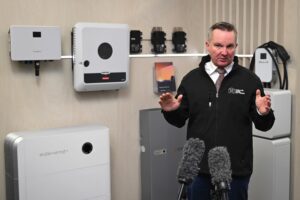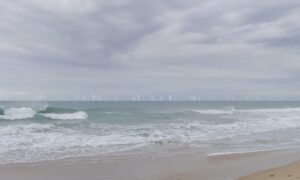A US utility is to trial a new battery storage technology that promises to deliver the holy grail of a grid based around wind and solar – ultra long storage of up to 150 hours that could revolutionise the way the storage technology is used and deployed.
Great River Energy – a major non-for-profit energy co-operative based in Minnesota – is teaming with Form Energy, a battery storage technology developer backed by Bill Gates, Australia’s Macquarie Capital, and others, to install a first-of-its-kind demonstration of Form’s unique “aqueous air flow” battery with ultra long storage.
The battery pilot will be a 1MW/150MWh, grid-connected storage system capable of delivering its rated power of one megawatt continuously for 150 hours, part of a broader plan to retire Great River’s main generator, a 1,151MW coal unit, and replace it with wind and ultimately battery storage and make 95 per cent of its power emissions free.
And while the battery component of this Great River Energy plan is relatively minor, if the pilot proves successful at delivering super-long duration and low cost storage, the implications for the electricity industry will be enormous.
Most big batteries currently in use in Australia and across the world are based on lithium-ion technologies, and often have very short storage time frames because they are used primarily to deliver super-fast, accurate and flexible grid services such as frequency control and inertia.
Even when used for storing wind and solar, the storage times are usually no more than four hours, beyond which it is presumed that pumped hydro has the cost advantage.
Form Energy was created three years ago by a group comprising a team from MIT, former Tesla battery leader Mateo Jaramillo, and Ted Wiley, a co-founder of Aquion. Its goal is build “ultra low cost” batteries with super long storage durations that would allow grid operators to store energy for seasonal storage, rather than just minutes and hours.
“We are going about this by developing a new kind of battery that would eliminate the need for coal and gas entirely, and allow for a 100% renewable, carbon free grid,” the battery company says on its website.
It says its technology leverages some of the “safest, cheapest, most abundant materials on the planet” and offers a clear path to low-cost, long-duration energy storage. It claims to be just a fraction of the cost of lithium-ion batteries.
It doesn’t say much about the battery technology itself, but an article in MIT’s Technology Review, late last year describes it as an “air-breathing aqueous sulfur flow battery.”
“A standard flow battery has two different electrolytes, known as the catholyte and the anolyte, each of which can be stored in big, easily swapped tanks. So if you want more storage, you can just add larger tanks while those other pricey parts, including the electrodes, remain the same,” the article says.
“To make it really inexpensive, though, the electrolytes filling those giant tanks need to be cheap as well. The key to the flow battery in the Joule paper is to use a sulfur-based solution as the anolyte. Sulfur is among the most abundant elements in the earth’s crust as well as a by-product of fuel refining, so it’s extremely cheap and can store a lot of energy.”
Jaramillo, now CEO of Form Energy, says the company’s vision is to unlock the power of renewable energy to transform the grid with low cost storage. “This (Great River) project represents a bold step toward proving that vision of an affordable, renewable future is possible without sacrificing reliability.
Form Energy has so far raised more than $US50 million ($A76 million) in two funding rounds. Its backers include Australia’s Macquarie Capital, Bill Gates’ Breakthrough Energy Ventures, an MIT offshoot called The Engine, a couple of leading cleantech venture companies, and Italian oil giant ENI (which owns several small solar projects in the Northern Territory).
It is also working with another European utility Enel Green Power, which owns the Bungala solar farms in South Australia and is also building the Cohuna solar farm in Victoria.
Form Energy and Enel recently released a “white paper” looking at the benefits of long term storage, which they said become manifest in storage beyond 10 hours (as Hydro Tasmania did recently with its own white paper looking at “deep storage” to support its own “battery of the nation” project, using pumped hydro.
The Form/Enel study long term storage at an optimal power level of 20 per cent and 40 per cent of nameplate wind farm capacity and an optimal duration between 13 and 23 hours, could boost the net present value of the wind farm by up to 50 per cent, and reduce the downside risk by up to 10 per cent under today’s market conditions.
A lithium-ion battery, with short term storage of four hours or less, would deliver a boost in net present value of around 27 per cent, and reduce the downside risk by up to six per cent.
These metrics were appealing to Minnesota’s Great River Energy, which is looking to replace its major coal plant – it has already shuttered more than 500MW of capacity, and boost its wind capacity to more than 1,760MW. One of its main issues are the wind lulls created by heat waves or a “polar vortex” that can often affect the area,
“Such storage could be particularly important during extreme weather conditions that last several days. Long-duration storage also provides an excellent hedge against volatile energy prices,” said Great River Energy vice President and chief power supply officer Jon Brekke in a statement.
Form Energy says the Minnesota project is a few years away from operations, and won’t be installed until 2023. But it says news of this contract could inject a new variable into grid infrastructure planning conversations elsewhere, and says it has spoken with about 100 different utilities.
“It’s important that the broader industry knows that this kind of thing is coming,” Jaramillo says. “If that causes regulators and other planners to pause and evaluate just how fast this stuff is going to show up, then fantastic.”
“Our vision at Form Energy is to unlock the power of renewable energy to transform the grid with our proprietary long-duration storage. This project represents a bold step toward proving that vision of an affordable, renewable future is possible without sacrificing reliability.”
Jesse Jenkins, an assistant professor at Princeton University who studies low-carbon energy systems engineering, says long duration energy storage solutions (LODES) will play an entirely different role in a clean electricity system than the conventional battery storage systems being deployed at scale today.
“Lithium-ion batteries are well suited to fast bursts of energy production, but they run out of energy after just a few hours. A true low-cost, long-duration energy storage solution that can sustain output for days, would fill gaps in wind and solar energy production that would otherwise require firing up a fossil-fueled power plant,” he said.
“A technology like that could make a reliable, affordable 100% renewable electricity system a real possibility.”
Great River Energy is Minnesota’s second-largest electric utility and the fifth largest generation and transmission cooperative in the US.







